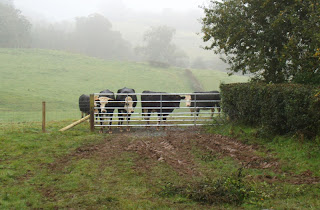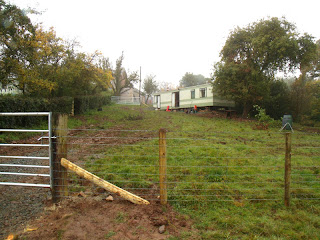I NEVER THOUGHT I COULD FEEL SO MUCH AFFECTION FOR FENCES AND GATES...
 |
| Ha ha... cows' trampling thwarted by gate |
 |
| Gate equally beautiful from the opposite direction |
Our plot here has just been fenced off which is brilliant as now the cows can’t wander through it, trashing stuff and trampling the ground into a quagmire – it’s still very, very wet underfoot here, thick clayey goo that you can barely walk through. But now we can start channeling some of the water, doing some planting and carry on putting our low-impact ideas into practice.
Reading about the march of the landless people in India and about the poor harvest around the world has reminded me how lucky we are to have access to this plot. It’s about a third of an acre so a very useful size when taken as an addition to the farm’s orchard and veg garden.
 |
| Lovely new gate leading from our plot into the orchard |
DEALING WITH WASTE AND KEEPING WARM
We’ve made a good start all ready to dealing with the waste we produce and by getting a massive wood-burning stove fitted. It’s been really interesting to see just how much of different kinds of waste we do produce, plastic, metal, paper & cardboard, grey water from washing etc and of course the good old pee and poo. The real shocker is the plastic... I remember a book from the seventies, “The Waste Makers” by Vance Packard – we’ve been aware of the global waste problem for decades but it’s just got worse and worse since then. No doubt you’ve noticed how everything you buy is packaged at least once and no doubt you’ve read about the vast floating mass of plastic that has gathered in the North Pacific, reportedly the size of Texas. At the moment we’re using our own plastic waste for insulation by stuffing milk cartons with it and packing them beneath the caravan. I’m not quite sure what we do with the stuff after that but by then we’ll hopefully have reduced the amount of plastic we bring on here, reduction has got to be the general answer. Where does the plastic come from anyway?...largely from fossil fuel materials and fossil fuel energy. And there’s lots of other things to do with it like the plastic bottle greenhouse we made at Cwm Harry.
COMPOSTING TOILET
The first thing we did when we got onto the land was to fit the caravan with a composting toilet. It’s easy and simple, smells less than the old WC and will provide valuable compost for the heavy clay soil. In fact, the nitrogen in your pee is so useful in helping other things to breakdown that it seesm amazing that we ever flushed it down the drain. (Don’t worry if you’re visiting, it’ll be going into land for fruit bushes and small trees not for veg.)
KEEPING WARM
I had hoped to make a rocket stove thermal mass heater instead of the wood stove which would have burned the wood much hotter and without the toxins released from smouldering logs but we’re always short of time... feeble excuse, feeble excuse...
Anyway, we’ll rig the stove, which is a monster, like something out of the Queen Mary, so that it burns hot and has plenty of thermal mass in and around it. Fuel for the stove comes from trees that have blown down on the farm, plenty of those so far - though we're using chainsaws and a tractor powered log splitter to harvest them... nothing's ever just totally simple is it?









